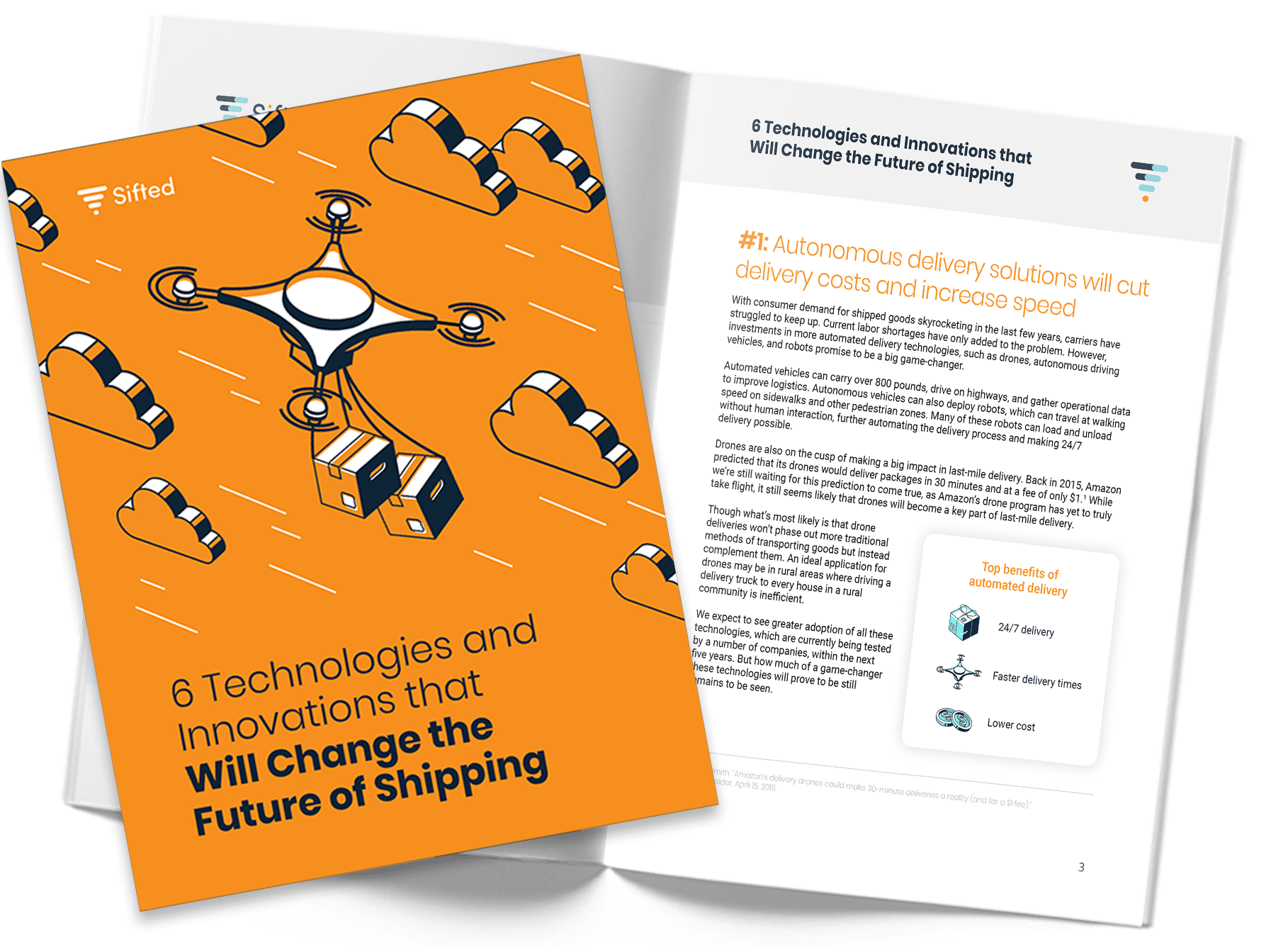The Importance of Choosing the Right Shipping Strategy
Shipping is a major costs of running an eCommerce store and it greatly affects the profitability of the business. This is why shippers need effective ways to control their shipping costs to focus on core business activities.
According to Statista, global retail eCommerce sales are projected to reach $7.4 trillion by 2025. To make the most of this opportunity, eCommerce businesses need to hone their shipping policies to attract new customers and retain old ones.
A robust shipping strategy helps you overcome shipping challenges, provide cost savings, and create a quality experience for your customers.
In this article, we’ll talk about actionable tips that you can use to optimize your shipping strategy. We’ll also go through best practices to maximize conversions and boost sales.
Are shipping charges catching you off guard? Gain full visibility into your supply chain operations with Sifted’s Logistics Intelligence solutions.

6 Technologies and Innovations Shaking Up the Shipping Industry
4 Shipping Strategies You Can Implement in 2022
Here are some strategies that can help you if you are concerned about shipping costs and customer expectations.
1. Offer free shipping
According to a 2021 Statista survey, 56% of consumers indicated that free shipping offered with the Amazon Prime subscription was the main reason for shopping on the eCommerce platform.
If you’re running an eCommerce business, free shipping can encourage customers to purchase without worrying about the cost of shipping.
Let’s explore 4 benefits of offering free shipping to your customers:
- More Sales: Free shipping is a great eCommerce strategy to increase sales and profits. It is also a good incentive for indecisive customers to make the purchase, because free shipping can be useful in sealing the deal.
According to Professor David Bell of the Wharton School of the University of Pennsylvania, “For whatever reason, a free shipping offer that saves a customer $6.99 is more appealing to many than a discount that cuts the purchase price by $10.”
- Increases Average Order Value: 58% of shoppers are likely to add items to their cart to receive free shipping. By setting a minimum shipping threshold, you can ensure that only customers spending over the threshold are eligible for free shipping. As customers add more items to their shopping cart to cross the threshold amount, it increases your average order size. You can use the extra revenue to partially cover the costs of free shipping.
- Boosts Customer Retention: Free shipping is a great way to attract new customers to your online store as well as retain old ones. A study by Material Handling and Logistics found that 91% of consumers are likely to shop with a business again and again that offers free shipping.
- Combats Cart Abandonment: Unexpected shipping fees are a major reason for 58% of customers to abandon their shopping carts at checkout. Free shipping lets you keep the product price constant throughout the purchase flow. This increases the likelihood of your customers completing the purchase, boosting your conversion rate and enhancing the customer experience.
The free shipping strategy can be a game changer for some businesses, but many small businesses cannot afford to offer free shipping to all their customers. And protecting the profit margin of your business is vital to your bottom line.
So what can you do?
Creating a shipping policy that combines free and paid delivery options allows online business owners to ensure they only offer free shipping to customers that are less likely to make the purchase otherwise. For example, you can offer a free shipping option with USPS Priority Mail (an economical option) and charge customers for shipping with FedEx two-day delivery.
Since 66% of shoppers expect free shipping on every online purchase, a great way to meet customer expectations is to incorporate the shipping cost into the product price. Take into account the average cost of shipping a package and include it in the pricing. Keeping the shipping price zero at the checkout ensures shoppers don’t get surprised with unexpected shipping costs, increasing their likelihood of making the purchase.
Sifted’s Logistics Intelligence solution empowers shippers through various cost optimizations, including route and contract optimization.
2. Charge exact shipping costs
Setting up real-time shipping on your online store is an effective eCommerce shipping strategy. Many eCommerce businesses display a shipping calculator at checkout that is connected with their shipping carrier. This allows customers to view live rates and delivery times from the shipping service provider, compare shipping methods, and calculate how much they will pay for shipping products.
If you know that you offer the best rates, a shipping cost calculator could actually help market your business as well. When customers are able to confirm the carrier rates on their own, it reduces cart abandonment and boosts your brand integrity.
3. Offer flat rates
Unexpected shipping fees dissuade 28% of consumers from placing an order online. Flat rate shipping enables online business owners to make shipping cost-effective for themselves and for their customers.
Many online sellers use standard shipping to keep their shipping costs low, resulting in slower delivery times (2-8 day shipping). Plus, the standard shipping costs are also affected by various factors including weight, size, and destination of the package.
Flat-rate shipping is a method where the shipping charges are determined by the box size or envelope used, instead of the dimensional weight of the package. It is generally not affected by peak season charges, enabling businesses to standardize their shipping expenses. Similarly, some carriers charge flat rates regardless of the destination of the package, as long as the parcel meets the set weight and size limits.
Flat rate shipping is a highly effective shipping strategy for eCommerce sellers who are looking to control their shipping costs and boost customer satisfaction.
4. Include alternative delivery methods
According to Via.Delivery, 18% of customers choose BOPA (Buy Online, Pickup Anywhere) when offered that choice at checkout.
Since many major shipping carriers like UPS and FedEx charge extra fees called residential charges (around $4.00 to $5.00) for delivery to residential addresses, the BOPA method can help to avoid these residential surcharges.
Prepare your eCommerce business with the right shipping strategy through Sifted’s Logistics Intelligence solution
Shipping products to your customers is complicated because of variables involved in the online shopping process such as shipping costs and customer expectations. But by implementing the actionable tips given in this article, you’ll be well on your way to optimizing your shipping strategy for conversions and customer satisfaction.
If you’re lacking a strong shipping strategy, Sifted Logistics Intelligence can help simplify shipping processes for your business.
Ready to optimize costs using AI-powered demand forecasting? Get a free demo from Sifted!











